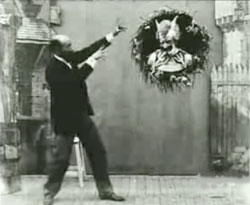 Four long unavailable films by Georges Melies have been digitally restored, as much as is possible, from delicate copies that survived in a Melies collection in Barcelona.
Four long unavailable films by Georges Melies have been digitally restored, as much as is possible, from delicate copies that survived in a Melies collection in Barcelona.
These began to be exhibited in 2007. The Barcelona "origins of cinema" collection numbers 200 films, more of which will be restored as funds come available.
Because the films are variously sprocketed or odd sizes predating standardization, with a variety of color additions, in sundry states of decay for the volatile emulsions or the cellulose, each film presents its own unique problems of restoration. New digital technologies make it all feasible, but still painstaking.
The four newly available films plus a fifth I recently encountered are reviewed below. For the first, Summoning the Spirits (Evocation Spirite, 1899), Melies personally appears on stage in the attitude of a magician, holding forth a circular flower wreath.
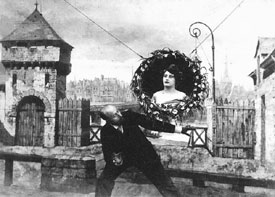 By special effects he is about to conjure images into the wreath. This is typical of many of trick films, reminding us Melies was a stage magician before he was a filmmaker By special effects he is about to conjure images into the wreath. This is typical of many of trick films, reminding us Melies was a stage magician before he was a filmmaker
The wreath is first hung from two wires to keep it stationary. With some presto motions of his arms, the Devil himself appears within the wreath, in cameo. The Devil is also played by Melies under heavy make-up. Our magician looks momentarily startled, as though intending to conjure something entirely different.
He corrects his error with some more flourishes. The Devil fades away & there appears within the wreath a beautiful maiden, inducing Melies to act rather self-congratulatory. He even throws a kiss. He bows to the maiden & she nods in acknowledgement.
Dematerializing the woman, he next conjures up an image of himself. Both Melieses laugh, the magician & his living cameo, until he dematerializes himself within the wreath.
Lastly he puts both his arms & his head through the wreath to prove it was an ordinary wreath. All this is achieved in about one minute.
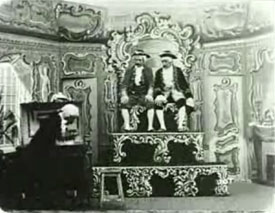 An impish magician or sorceress "jester" (triboulet) is played by Georges Melies, as is often his choice of casting, in The Human Pyramid; aka, The Pyramid of Triboulet (La Pyramide de Triboulet, 1899).
An impish magician or sorceress "jester" (triboulet) is played by Georges Melies, as is often his choice of casting, in The Human Pyramid; aka, The Pyramid of Triboulet (La Pyramide de Triboulet, 1899).
The jester magically appears atop a three-stepped pyramid constructed in a well appointed room. He dances as if weightless down the "staircase" of stacked ornamented boxes, & immediately materializes a sailor's trunk, opening the lid twice.
On the second lift of the lid, a man steps out in period garments, including hosiery & three pointed hat. He climbs the pyramid, & sits down on top.
The impish jester opens the sea trunk again & out steps a similarly clad man, who climbs the pyramid & sits next to the first gent.
A third man steps out of the trunk, & the magician turns him into three identically clad gents. They all seat themselves on the second tier of the pyramid.
A sixth man is materialized from the trunk, & transformed into four men, who sit on the lowest tier of the pyramid. The sea trunk is then vanished with a sweep of the magician's arm, just before he turns the nine gentlemen into nine ladies with fans & period gowns.
Lastly the magician climbs to the top of the pyramid of ladies, & the poorly preserved footage suddenly ends. Again, all is achieved in about one minute.
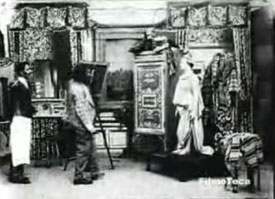 The Artist & the Dummy; aka, The Artist & the Mannikin (L'Artiste et le Mannequin, 1900) is set in an artist's studio. We see an artist (played by Melies in a big phony beard) arranging the clothes of a mannequin as his subject.
The Artist & the Dummy; aka, The Artist & the Mannikin (L'Artiste et le Mannequin, 1900) is set in an artist's studio. We see an artist (played by Melies in a big phony beard) arranging the clothes of a mannequin as his subject.
On the opposite side of the room is a male assistant or butler wearing an apron, & a young woman, probably the artist's wife, addressing the butler covertly. She then exits the stage.
The artist lifts his light-weight mannequin & places her on a little dais, ready to paint. While the artist's back is turned, the young woman returns from around a corner, quickly hides the mannequin, & takes the mannequin's place.
A jest is now in play, for whlich the butler has been fully apprised. As the artist moves some stuff about he has his back to the "mannequlin" & she wacks him with a handy broom before returning to her motionless stance.
While helping the artist back to his feet, the laughing butler whispers into his ear that the young lady had returned & is pretending to be the model.
But while the artist plans to use this information to turn the tables, the young woman puts the mannequin back on the little dais, just before the artist whirls around wacking the mannequin with his broom.
The comedy is somewhat spoilt by the fact that he hit the mannequin so hard that had the young lady still been standing there he'd surely have caused her injury.
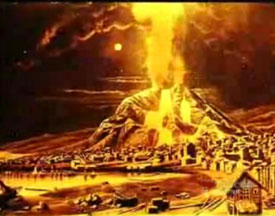 Achieved with a marvelouos scale model, we are shown a volcano erupting over a sprawling little city or large village by a bay, in Eruption of Mount Pelee; aka, Volcanic Eruption in Martinique (Eruption Volcanique a la Martinique, 1902).
Achieved with a marvelouos scale model, we are shown a volcano erupting over a sprawling little city or large village by a bay, in Eruption of Mount Pelee; aka, Volcanic Eruption in Martinique (Eruption Volcanique a la Martinique, 1902).
The poorly preserved film is tinted yellow for the opening scene, the dark sky greenish. A little moon shines through cloud cover as the volcano's smoke spews upward.
A second vent bursts open at the top of the increasingly wrathful volcano, sending stones flying onto the town, as the color tint of the sky shifts to dark blood-red then to bright fiery reds, orange, & yellows.
The city bursts into flames as broad rivers of glowing lava rush down the mountain's lumpy side, right into the sprawling viillage. Smoke clouds the entire scene, & a model of a house placed closest to the camera bursts into flame.
"Actuality films" showed real events as simple as pedestrians on a sidewalk, but this exciting one-minute film was called a "reconstructed actuality." That would generally indicate a re-enacted scene of daily life, but in this case it's a uniquely all-FX extravaganza of a catastraphe constructed from paper mache & an array of fireworks.
Melies has imaginatively reconconstructed the actual eruption which occurred earlier the same year. The catastrophe comes off as a charming primitive today, but in 1902 it must've been quite horrific with its lurid colors (though not all copies would've been hand colored), & the audiences fully aware that on the Eighth of May, 28,000 inhabitants of St. Pierre were killed, with only one survivor to bare witness.
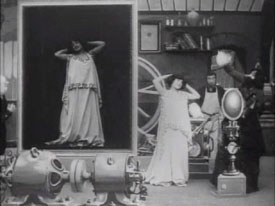 One of Melies' more nonsensical trick films is Long Distance Wireless Photography; aka, Remote Electrical Photography (Photographie electrique a distance, 1908).
One of Melies' more nonsensical trick films is Long Distance Wireless Photography; aka, Remote Electrical Photography (Photographie electrique a distance, 1908).
We see a large picture frame with a mechincal device behind it. The device is an "electrotachyoscope."
It is used to project a picture of the Three Graces from a small painting into the large frame. The projected images, however, comes to life, so the electrotachyoscope is no mere projector.
Next, a living woman stands in front of the device & her image is projected onto the screen. The projected version moves differently than the actual woman, as if having its own consciousness.
An old woman is seated before the device & has just her head projected into the frame. The old lady laughs, but the head on the screen seems angry, having a completely different personality.
An old man's head is next projected, but he comes out as a mechanical monkey head. The projection device has gone wonky & causes several closing moments of nutty merriment.
copyright © by Paghat the Ratgirl
|
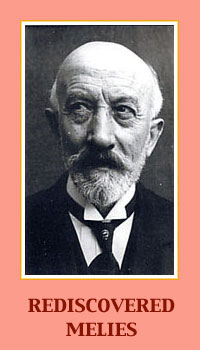

 By special effects he is about to conjure images into the wreath. This is typical of many of trick films, reminding us Melies was a stage magician before he was a filmmaker
By special effects he is about to conjure images into the wreath. This is typical of many of trick films, reminding us Melies was a stage magician before he was a filmmaker


